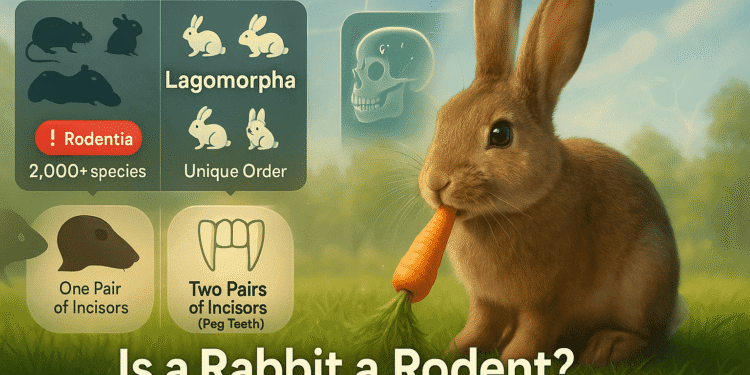Is a Rabbit a Rodent? The Surprising Truth About These Fluffy Creatures
Have you ever looked at your pet rabbit nibbling on a carrot and wondered if it’s related to mice or hamsters? You’re not alone in this curiosity. The question “is a rabbit a rodent?” is one of the most common misconceptions in animal classification, and the answer might surprise you more than you think.
Here’s the straightforward answer: No, rabbits are not rodents. While they share some similarities with rodents like constantly growing teeth and small size, rabbits belong to an entirely different order called Lagomorpha. Think of it like confusing a dolphin with a shark – they might live in the same environment and have similar shapes, but they’re completely different types of animals.
This classification confusion affects millions of pet owners, students, and even some veterinarians who aren’t specialized in exotic animals. Understanding the real differences isn’t just academic trivia – it can actually impact how you care for these adorable creatures.
Understanding Animal Classification Basics
What Makes an Animal a Rodent?
Before we dive into why rabbits aren’t rodents, let’s understand what actually defines a rodent. The order Rodentia is the largest group of mammals, making up about 40% of all mammal species. What unites all these creatures isn’t just their size or cuteness factor.
Rodents share several key characteristics that set them apart from other mammals. They have a single pair of continuously growing incisors in both their upper and lower jaws. These teeth are like nature’s chisels, perfect for gnawing through tough materials. Ever wondered why your hamster seems to chew everything? That’s their natural instinct to keep those ever-growing teeth at the right length.
The name “rodent” actually comes from the Latin word “rodere,” which means “to gnaw.” These animals have specialized jaw muscles and skull structures that make them incredibly efficient at this gnawing behavior. From the tiny harvest mouse to the massive capybara, all rodents share this fundamental dental blueprint.
The Role of Taxonomy in Animal Classification
Taxonomy is like nature’s filing system, organizing all living things into groups based on their evolutionary relationships. Scientists use a hierarchical system that goes from broad categories down to specific species. It’s similar to how you might organize your music library – starting with genres, then artists, then albums, and finally individual songs.
This system helps us understand not just what animals look like, but how they’re related through millions of years of evolution. When we say rabbits aren’t rodents, we’re not just talking about superficial differences – we’re talking about fundamental evolutionary paths that diverged long ago.
The classification system considers everything from DNA sequences to bone structure, reproductive methods, and even biochemical processes. It’s a comprehensive approach that reveals the true family tree of life on Earth.
The Great Rabbit Misconception
Why People Think Rabbits Are Rodents
The confusion between rabbits and rodents isn’t just random – there are legitimate reasons why people make this mistake. Both groups are relatively small mammals that are often kept as pets. They both have those adorable twitching noses and seem to spend a lot of time nibbling on things.
Historically, rabbits were actually classified as rodents until the early 20th century. Scientists didn’t have the advanced tools we have today to study animal relationships, so they grouped animals based primarily on observable characteristics. If it looked like a rodent and acted like a rodent, it must be a rodent, right?
This historical classification stuck around in popular culture long after scientists corrected it. Many pet stores still group rabbit supplies with rodent products, and casual conversations often lump them together. It’s like how we still say the sun “rises” even though we know the Earth rotates – old ideas have staying power.
Common Characteristics That Confuse Pet Owners
When you watch a rabbit eat, the similarities to rodents seem obvious. They both sit up on their hind legs, use their front paws to hold food, and make similar chewing motions. Both groups also tend to be active during dawn and dusk hours, a behavior called crepuscular activity.
The size factor plays a huge role in this confusion too. Most people’s experience with mammals comes from pets, and the small pet mammal category seems to naturally include rabbits alongside hamsters, gerbils, and guinea pigs. Pet stores capitalize on this by selling similar products for all these animals, from cages to bedding to toys.
Both rabbits and many rodents are also prey animals, which means they share certain behavioral traits like being easily startled, hiding when threatened, and having eyes positioned on the sides of their heads for better peripheral vision. These survival adaptations make them seem more alike than they actually are.
Scientific Classification of Rabbits
Meet the Lagomorphs
Rabbits belong to the order Lagomorpha, a name that means “hare-shaped” in Latin. This order includes rabbits, hares, and pikas – those adorable round creatures that look like a cross between a hamster and a rabbit but live in mountainous regions. There are only about 80 species in the entire Lagomorpha order, compared to over 2,000 rodent species.
Lagomorphs evolved as a distinct group around 50 million years ago, developing unique adaptations that set them apart from their rodent cousins. These adaptations weren’t just cosmetic changes – they represented fundamental shifts in how these animals processed food, moved through their environment, and survived as prey species.
The lagomorph family tree is relatively simple compared to the complex branching of rodents. You’ve got the Leporidae family (rabbits and hares) and the Ochotonidae family (pikas). That’s it – just two main branches in a order that’s been stable for millions of years.
Order Lagomorpha Explained
Understanding Lagomorpha requires thinking about evolutionary pressure and adaptation. These animals developed in environments where quick escape was essential, leading to their characteristic powerful hind legs. Unlike rodents, which developed diverse survival strategies from burrowing to climbing to swimming, lagomorphs specialized in speed and efficient digestion.
The lagomorph body plan is remarkably consistent across species. Whether you’re looking at a tiny cottontail rabbit or a massive Arctic hare, you’ll see the same basic blueprint: long ears for detecting predators, powerful hind legs for escape, and specialized digestive systems for processing tough plant material.
This consistency suggests that the lagomorph design was so successful in its ecological niche that there wasn’t evolutionary pressure to diversify into dramatically different forms. It’s like finding the perfect recipe and sticking with it for millions of years.
Key Differences from Rodentia
The most obvious difference lies in their dental structure. While rodents have one pair of incisors in each jaw, lagomorphs have two pairs in the upper jaw. Behind the large front incisors that everyone notices, rabbits have a smaller second pair called peg teeth. These aren’t just decorative – they play a crucial role in how rabbits process their food.
This dental difference reflects a fundamental distinction in how these animals approach nutrition. Rodents are generally opportunistic feeders with varied diets, while lagomorphs are specialized herbivores. Their entire digestive system, from teeth to gut bacteria, is optimized for breaking down cellulose and extracting maximum nutrition from plant material.
The jaw structure also differs significantly. Lagomorphs can move their jaws side to side in a grinding motion, something that’s much more limited in rodents. This lateral jaw movement is essential for breaking down tough plant fibers and is supported by different muscle arrangements and skull architecture.
Physical Differences Between Rabbits and Rodents
Dental Structure Comparison
Let’s talk teeth – the most defining characteristic of both groups. When you look at a rodent’s mouth, you’ll see those prominent front incisors designed for gnawing. They’re typically yellow or orange in color and curve slightly backward. These teeth grow continuously throughout the animal’s life, which is why rodents need to constantly chew to keep them at the proper length.
Rabbit teeth tell a different story entirely. Yes, they also grow continuously, but the structure is more complex. Those peg teeth we mentioned earlier sit directly behind the main incisors and help guide food as the rabbit chews. This gives rabbits much more precision in their chewing motion, allowing them to efficiently process fibrous plant material.
The chewing motion itself is completely different between the two groups. Rodents primarily use an up-and-down gnawing motion, perfect for breaking through hard surfaces like nuts or wood. Rabbits use a more circular, grinding motion that’s ideal for breaking down plant cell walls and extracting nutrients from tough vegetation.
Digestive System Variations
Here’s where things get really interesting from a biological perspective. Rabbits have developed one of the most unique digestive strategies in the mammal world – they actually eat some of their own feces. Before you get grossed out, this behavior called cecotrophy is a brilliant evolutionary solution to a complex problem.
Plant material is notoriously difficult to digest, especially for small mammals with fast metabolisms. Rabbits solve this by having a specialized part of their digestive system called the cecum, which is like a fermentation chamber where beneficial bacteria break down cellulose. The first time food passes through, it forms soft, nutrient-rich pellets called cecotropes that the rabbit immediately re-ingests.
This double-digestion process allows rabbits to extract maximum nutrition from low-quality food sources. Rodents, while they may occasionally practice similar behaviors, don’t have this specialized system to the same degree. Their digestive strategies are more varied and adapted to their more omnivorous diets.
Unique Rabbit Features
Beyond digestion, rabbits have several physical features that clearly distinguish them from rodents. Their ears are proportionally much larger and more mobile, capable of rotating nearly 180 degrees to detect predators from multiple directions. This isn’t just about hearing – those big ears also help regulate body temperature by radiating excess heat.
The famous rabbit foot isn’t just lucky – it’s a engineering marvel. Rabbit hind feet are elongated and powerful, with thick fur padding that provides both insulation and traction. Their bone structure is different too, with a longer pelvis and specialized spine that allows for those spectacular jumping abilities.
Even their eyes are positioned differently. While many rodents have eyes that are more forward-facing for depth perception while foraging, rabbit eyes are positioned on the sides of their heads for maximum peripheral vision. They can literally see behind themselves without turning their heads – a crucial advantage when you’re somebody’s lunch menu.
Evolutionary History and Development
How Rabbits Evolved Separately
The evolutionary story of rabbits and rodents is like two rivers that started from the same mountain but carved completely different paths to the sea. Both groups descended from early placental mammals that lived around 85 million years ago, but they split into separate evolutionary paths much earlier than most people realize.
Molecular studies suggest that the split between lagomorphs and rodents occurred approximately 80 million years ago, during the late Cretaceous period when dinosaurs still ruled the Earth. This means rabbits and rodents have been developing separately for longer than the time since the asteroid impact that ended the dinosaur era.
During this massive time span, each group faced different environmental challenges and developed distinct solutions. Rodents diversified into an incredible array of forms – from tiny shrews to massive beavers, from desert-dwelling kangaroo rats to aquatic muskrats. Lagomorphs, meanwhile, perfected their particular niche as fast-moving herbivores.
The Fossil Record Evidence
Paleontologists have uncovered fascinating evidence of early lagomorph evolution in fossil deposits around the world. Some of the earliest lagomorph fossils come from Asia and show animals that were already distinctly different from their rodent relatives. These ancient creatures had the characteristic lagomorph dental pattern and body structure, suggesting that the key innovations happened very early in their evolutionary history.
One of the most interesting fossil discoveries is Mimolagus, an early lagomorph from about 30 million years ago. Even at this ancient date, the animal showed clear lagomorph characteristics, including the distinctive peg teeth and elongated hind limbs. This suggests that the lagomorph body plan was established much earlier than previously thought.
The fossil record also shows us that lagomorphs were once much more diverse than they are today. Ancient species included some surprising variations, including lagomorphs with different ear sizes, leg proportions, and even some that may have been more omnivorous than their modern descendants.
Common Rodents vs. Rabbits: A Side-by-Side Analysis
Mice and Rats vs. Rabbits
When people think of rodents, mice and rats usually come to mind first. These animals represent the classic rodent body plan – small, agile, with prominent incisors and long tails. Comparing them directly to rabbits highlights just how different these animal groups really are.
Mice and rats are incredible athletes in their own right, but their athleticism is different from rabbits. Where rabbits excel at explosive jumping and quick direction changes, mice and rats are masters of squeezing through impossibly small spaces and climbing vertical surfaces. A mouse can fit through any opening larger than its skull, while rabbits need much more substantial escape routes.
The dietary differences are equally striking. While rabbits are obligate herbivores that can’t properly digest meat, mice and rats are opportunistic omnivores. They’ll eat everything from seeds and fruits to insects and even small amounts of meat when available. This dietary flexibility has helped rodents colonize virtually every habitat on Earth.
Guinea Pigs and Hamsters Comparison
Guinea pigs present an interesting case because they’re often grouped with rabbits in pet stores, but they’re actually rodents. However, guinea pigs are cavies (family Caviidae) and have some interesting convergent evolution with rabbits. Both are herbivores with somewhat similar digestive needs, which is why their care requirements often seem similar.
Hamsters, on the other hand, are classic rodents with all the typical characteristics. They’re primarily granivores (seed-eaters) with cheek pouches for storing food – something no lagomorph has ever developed. Their burrowing behavior and hoarding instincts are distinctly rodent-like and completely foreign to rabbit behavior patterns.
The social structures also differ dramatically. Most rabbits are social animals that live in complex warren systems with established hierarchies. Hamsters are largely solitary, and many species will fight if housed together. This reflects their different evolutionary pressures and survival strategies.
Behavioral Differences
Behavior is where the differences between rabbits and rodents become most apparent to pet owners. Rabbits communicate through a complex system of body language that includes ear positions, chin rubbing, and specific movement patterns. They’re capable of learning routines and can even be litter trained with patience.
Rodents typically have simpler communication systems, though they’re certainly not unintelligent. They rely more on scent marking and vocalizations that are often outside human hearing range. Their play behaviors are also different – rodents tend to explore and manipulate objects, while rabbits are more likely to engage in social play and territory-related behaviors.
The stress responses of these animals also differ significantly. Rabbits can literally die from fright due to their intense prey responses, while most rodents are more resilient to sudden stresses. This has important implications for pet care and handling techniques.
Nutritional and Care Requirements
Why Diet Matters in Classification
The dietary needs of rabbits versus rodents reflect their fundamental biological differences and provide practical proof of why the classification matters. Rabbit nutrition is incredibly specialized and unforgiving – feed a rabbit the wrong diet, and you can cause serious digestive problems or even death.
Rabbits require a diet that’s primarily high-quality hay, supplemented with leafy greens and a small amount of pellets. They can’t digest simple carbohydrates well, and foods that are perfectly safe for rodents – like corn, nuts, or seeds – can cause dangerous digestive upset in rabbits. Their cecotrophy behavior means they need specific types of fiber to maintain proper gut health.
Rodents, depending on the species, often do well on mixed diets that include seeds, grains, fruits, and vegetables. Many can handle simple carbohydrates without problems, and some even require them for proper nutrition. This dietary flexibility reflects their evolutionary history as opportunistic feeders rather than specialized herbivores.
Specialized Rabbit Nutrition Needs
Understanding rabbit nutrition requires thinking about their wild diet and digestive system. In nature, rabbits spend most of their waking hours foraging for a variety of grasses, herbs, and other plant materials. They’ve evolved to extract maximum nutrition from these relatively low-energy foods through their unique digestive process.
The cecotrophy behavior we discussed earlier means rabbits essentially digest their food twice. The first pass produces soft cecotropes that are immediately re-ingested, while the second pass produces the hard, dry pellets that most people associate with rabbit droppings. Disrupting this process through improper diet can lead to serious health problems.
Vitamin C is another interesting difference. While most rodents (guinea pigs being a notable exception) can synthesize their own vitamin C, rabbits cannot and must obtain it from their diet. However, unlike guinea pigs who need vitamin C supplements, rabbits typically get adequate amounts from fresh vegetables and don’t usually need supplementation.
Impact on Pet Ownership and Veterinary Care
Different Medical Needs
The classification difference between rabbits and rodents isn’t just academic – it has real-world implications for pet care and veterinary treatment. Rabbits are considered “exotic” pets by most veterinary practices, requiring specialized knowledge and equipment that many general practice vets don’t have.
Rabbit medicine is genuinely different from rodent medicine. Their sensitive digestive systems mean that many antibiotics safe for rodents can be fatal to rabbits by disrupting their gut bacteria. Their susceptibility to stress means that even routine procedures require different handling techniques and environmental considerations.
Anesthesia protocols differ significantly between the groups as well. Rabbits have unique respiratory and cardiovascular characteristics that require specialized monitoring and drug protocols. What works perfectly for a hamster or guinea pig might be dangerous for a rabbit of the same size.
Housing and Environmental Requirements
Proper housing for rabbits reflects their lagomorph nature rather than rodent needs. Rabbits need substantial space to hop and run – their powerful hind legs aren’t just for show, they’re essential for proper muscle development and bone health. The traditional “rabbit hutch” is actually inadequate for most domestic rabbits.
Rodents typically do well in smaller enclosures relative to their body size, with many species being comfortable in complex vertical habitats with tubes and platforms. Rabbits prefer more horizontal space and don’t typically climb like many rodents do. They’re also more social and often do better in pairs or groups, while many rodent species prefer solitary living.
Temperature and humidity requirements also differ. Rabbits are generally more sensitive to heat due to their inability to pant effectively, while many rodent species have adapted to a wider range of environmental conditions. These differences affect everything from cage placement to seasonal care considerations.
Debunking Other Animal Classification Myths
What About Hares and Pikas?
Now that we’ve established that rabbits aren’t rodents, let’s clarify the relationships within the lagomorph family. Hares and rabbits are often confused, but they’re actually different species within the same family. Hares tend to be larger, with longer ears and legs, and their young are born fully furred and able to move around immediately.
Pikas are the third group of lagomorphs and probably the least familiar to most people. These small, round animals live primarily in mountainous regions and don’t look much like rabbits at first glance. However, they share the characteristic lagomorph dental structure and many behavioral traits with their more famous cousins.
All three groups – rabbits, hares, and pikas – share the fundamental lagomorph characteristics that distinguish them from rodents. They all have the double incisor structure, specialized digestive systems, and similar reproductive patterns. Understanding these relationships helps clarify why classification based on evolutionary relationships is more meaningful than classification based on appearance alone.
Other Commonly Misclassified Animals
The rabbit-rodent confusion isn’t unique – there are several other animals that people commonly misclassify based on appearance or behavior. Tree shrews, despite their name, aren’t actually shrews at all but belong to their own distinct order. Flying lemurs aren’t lemurs and don’t actually fly, but glide using specialized membranes.
Even some animals we think of as rodents aren’t actually rodents. Elephant shrews, despite their small size and mouse-like appearance, are more closely related to elephants than to any rodent. This demonstrates how misleading appearances can be when it comes to evolutionary relationships.
These classification surprises highlight the importance of genetic and anatomical studies in understanding animal relationships. What seems obvious from casual observation often turns out to be completely wrong when we dig deeper into evolutionary history and biological relationships.
Conclusion
The question “is a rabbit a rodent?” opens up a fascinating window into animal classification, evolutionary biology, and the importance of accurate scientific understanding. While rabbits and rodents share some superficial similarities that have confused people for generations, they represent distinct evolutionary lineages that have been separate for approximately 80 million years.
Rabbits belong to the order Lagomorpha, characterized by their unique double-incisor dental structure, specialized herbivorous digestive system, and distinctive body plan optimized for quick escape from predators. These fundamental differences aren’t just academic curiosities – they have practical implications for pet care, veterinary treatment, and our understanding of how life has diversified on Earth.
The historical confusion between rabbits and rodents serves as a reminder that scientific classification is an ongoing process that improves as our tools and knowledge advance. What seems obvious from casual observation often requires deeper investigation to understand fully. In the case of rabbits, that deeper look reveals creatures that are uniquely adapted to their ecological niche and quite distinct from their rodent neighbors.
Understanding these relationships enriches our appreciation for the complexity and beauty of evolution. Every time you watch a rabbit hop across a lawn or see one grooming its distinctive long ears, you’re observing millions of years of specialized evolution at work. These aren’t just small rodents – they’re members of an ancient and successful lineage that has found its own unique path through the challenges of survival.
Frequently Asked Questions
1. Why were rabbits originally classified as rodents?
Historically, animal classification was based primarily on observable characteristics rather than evolutionary relationships. Since rabbits and rodents are both small mammals with constantly growing teeth and similar behaviors, early scientists grouped them together. It wasn’t until the 20th century, with advances in comparative anatomy and later genetic analysis, that scientists recognized rabbits belonged to their own distinct order, Lagomorpha.
2. What’s the main difference between rabbit teeth and rodent teeth?
The key difference is that rodents have one pair of incisors in each jaw, while rabbits have two pairs in the upper jaw. Behind the large front incisors that everyone notices, rabbits have smaller “peg teeth” that help them process plant material more efficiently. This dental structure reflects their specialized herbivorous diet compared to the more varied diets of most rodents.
3. Can rabbits and rodents interbreed since they seem so similar?
No, rabbits and rodents cannot interbreed because they belong to completely different orders (Lagomorpha and Rodentia respectively). They’ve been evolutionarily separate for about 80 million years, making them as genetically different from each other as either is from many other mammal groups. Successful breeding requires much closer evolutionary relationships.
4. Do rabbits need different veterinary care than rodents?
Yes, rabbits require specialized exotic animal veterinary care that’s quite different from rodent medicine. Their sensitive digestive systems mean many antibiotics safe for rodents can be fatal to rabbits. They also have different anesthesia requirements, stress sensitivities, and nutritional needs that require veterinarians trained specifically in lagomorph medicine.
5. Are there any rodents that are commonly mistaken for rabbits?
While most rodents are easily distinguished from rabbits, guinea pigs are sometimes confused with young rabbits due to their similar size and herbivorous diet. However, guinea pigs have the characteristic single pair of incisors, different ear shape, and lack the powerful hind legs that define lagomorphs. Chinchillas might also be confused with small rabbits due to their soft fur, but they’re clearly rodents when you examine their teeth and body structure.
Please don’t forget to leave a review.









